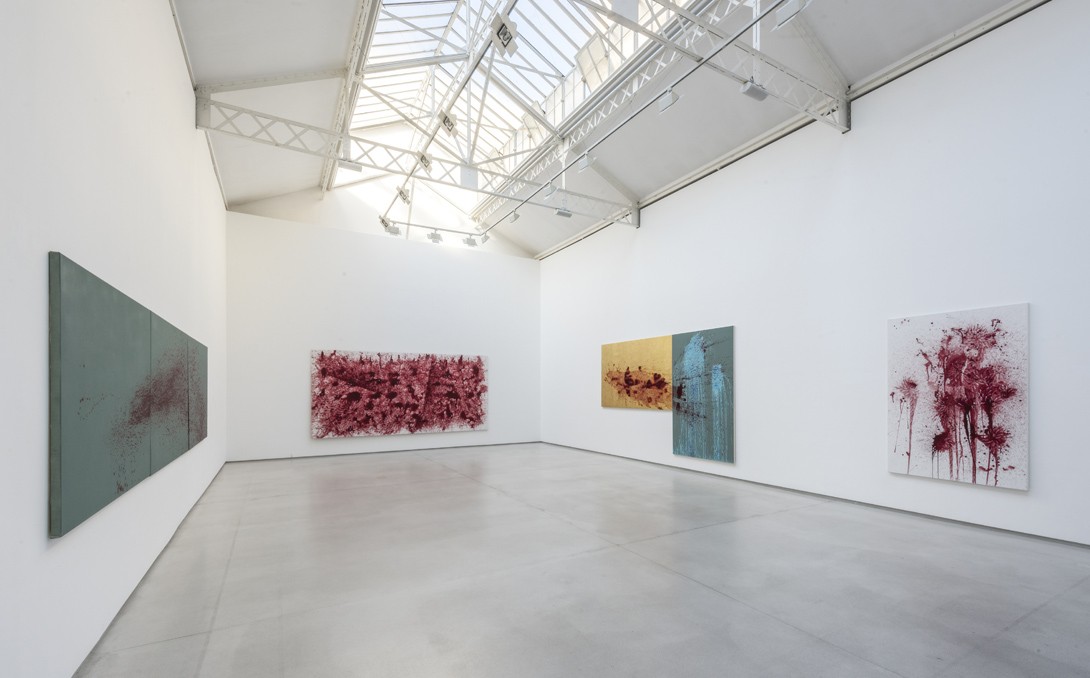
Imran Qureshi’s unique art work ‘Idea of Landscape’ is displayed at ROPAC, Paris

Imran Qureshi is at a point now where he possibly spends much more of his time hovering just above the clouds than he is rooted to earth. Softly spoken and looking jaded for all of the accumulated air miles under his belt, Qureshi is fundamentally a very honest and well-intentioned artist, who still has trouble comprehending his success.
His inaugural solo show at ROPAC, Paris comes off the back of two major site specific commissions--And They Still Seek the Trace of Blood at the Bibliothéque Ste-Geneviève in 2014 (for which Parisians were invited to queue to enter the academic enclave well into the night) and Two Loves at Quai d’Austerlitz in 2014.
Qureshi has since drawn together a body of works that for him deal with the landscape as a battle ground for a new kind of emotional aesthetic. He describes his works as "either including the human body or those that have the aura of his body present."
Idea of Landscape reads as an entirely two-dimensional show, of sizable canvases and delicate drawings that are sited as painterly explosions throughout the gallery. The decision to deliver Qureshi’s show in September draws with it a great deal of autumnal light that floods the impressive central space and illuminates the artist’s canvases; that in-situ creates an indulgent arena from which to view his new body of works. All of which are significantly shaped by his mastery of painterly techniques that borrow as much from the decorative elements of his seminal installations in New York and Paris; and much as they are decided by the nature of paint itself, as it falls loosely in the directions of his making.
Tormented by the invasiveness of violence, Qureshi presses home "the idea of landscape has changed after 9/11. Because the land which is full of life and of nature, is in a second transformed into a bloody mass of landscape. And it’s quite a disturbing thing, because when we think of a landscape painter we have very peaceful images in our mind, but here it is something else. It is a different kind of landscape, which is more about the reality of the situation."
And in order to qualify his work’s bodily and bloody appearance, Qureshi recalls a particularly violent incident in which two boys were lynched by a mob in the Punjab district of Pakistan that influenced the works principal theme. "So with All Are The Colour of My Heart (2015), the body came into my work in this way for the first time in 2010. When there was an incident of two brothers being killed in a remote part of Punjab. And somebody made a video of the incident and it was leaked to the media and shown on TV which led to a huge reaction to the whole incident. I saw the video and was unable to see it fully, because it was so violent. And after I had a few seconds flashback of something of the event in my mind." This led to Qureshi colouring his body red and submitting himself to his canvas-cum-stretcher, as though a casualty of violence.
It proved to be a turning point for a whole series of paper and panel works that for the artist were shaped as much by a history of violence in his country, as the riposte of many thousands of people against such animalistic actions. And rather than being guilty of inertia "people were still alive and that they are reacting, with a unanimous desire for peace. Because the majority are not like this, there are only a few people acting violently; but not the rest of the people. So that was the reasoning for combining the body with blood red. And of the bloody body with the floral patterns emerging from it. As hope appears to be coming out of a dead body. It is that kind of an idea."
And as much as his new works merit our attention, it is as interesting to purvey his sudden and successful rise. Qureshi fondly describes his Sharjah Biennial commission in 2011, in which he decorated the courtyard of the Beit Al Serkal building with the work Blessings Upon the land of my Loveas the turning point. Qureshi’s signature style of layering beauty over violence was heralded when he received the biennale award that year. Which in turn lead more significantly to recognition as Deutsche Bank’s artist of the year in 2013--like a monsoon this led to a whole series of high profile shows in less than twelve months. Qureshi’s ROPAC works are a combination of lashings of his creative spirit, reeled in by pockets of miniature detail that appear to anchor his work, and give it its cultural currency. And for the artist as reluctant as he originally was to take on miniature painting, it has proved the making of the man, and the merit of his new show.